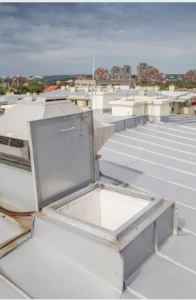Roof access hatches offer a way of getting direct access to rooftop areas of a building. They allow you to keep the heat in during the coldest months of the year and let the sun’s rays out during the hottest seasons.
 Ensure safety
Ensure safety
When opening roof access hatches Adelaide, you must consider the safety factor. Some key elements include a self-closing hatch gate, a ladder safety post, and a good guardrail. The best way to ensure safety is to follow the rules.
A ladder safety post is a telescoping steel post permanently mounted to the top two fixed ladder rungs in a roof hatch. It provides a stable, secure place for workers to hold on to while entering the opening in an upright position.
A roof access hatch can be a critical part of a commercial building’s roof. However, while they provide reliable access to the rooftop, they pose hazards when left unattended. If a worker falls on the open hatch, the odds are they will suffer fatal injuries.
A personal fall arrest device may be the only option for workers near an open hatch. Alternatively, a self-closing hatch door can prevent employees from falling into the hole.
A good guardrail will help keep a person from falling into a skylight. It should withstand a downward force of 200 pounds and be durable enough to withstand little traffic.
Surprisingly, many workers are injured or even killed yearly in roof hatch opening falls. In avoiding these tragedies, it’s essential to ensure that you are adhering to the latest roof hatch safety standards.
Installing a ladder safety post is one of the most effective ways to maintain compliance with OSHA regulations. It’s an extension device and a great way to provide a stable handhold for workers while entering the opening in an upright position.
For a truly effective roof hatch guard rail, it’s essential to ensure that the surface is smooth and that the fence does not grab the worker’s skin. Additionally, it’s wise to ensure the rail is 42 inches above the walking surface.
Provide direct access to rooftop areas
Roof access hatches offer safe and convenient access to rooftop areas of commercial buildings. They can access various sizes, including solar panels, heating, ventilation, air conditioning (HVAC) systems, generators, and other roof-mounted devices. Depending on the building type and the access purpose, there are several hatches to choose from.
Choosing the right one involves selecting the proper design, construction material, and features. In addition, the size of the hatch will depend on the equipment to be accessed.
If the purpose of the hatch is to facilitate the installation of large equipment into the building, then a larger hatch will be needed. This hatch will also be necessary if maintenance workers carry a wide variety of equipment or tools onto the roof.
Another option is to have a ship stair, which may be used to access the rooftop. These stairways may be used by office or industrial buildings with high ceilings.
Other buildings with occupied roofs, such as schools, apartments, condominiums, and shopping centres, may have daylighting hatches that allow natural light into the roof. However, these are not permitted to obstruct aerial ladder access.
In addition, the building code must allow for safe egress to the rooftop, providing a stairway. To comply, the stairs must be marked at floor level, and the stairway access must be marked with a sign.
Alternatively, the roof access hatches Adelaide area must be protected by a guardrail. The guardrail must be at least 10 feet from the roof’s edge.
Access hatches are commonly specified on commercial buildings, such as manufacturing facilities, offices, and wastewater treatment plants. Because of their low profile, they are also a safe way for workers to enter and exit a rooftop.
When selecting a hatch, selecting one with a low profile and a door built into the roof slope is crucial. It’s also recommended that the hatch be made of aluminium, which offers the best corrosion resistance. Finally, select a hatch that has fully insulated curbs and welded corners.
Keep heat in during winter and repel the sun’s heat in summer
Roof access hatches are an essential aspect of any establishment. They keep the heat out during the winter and the cold out during the summer. To ensure that your establishment remains cool and dry, you must ensure that your roof access hatches are in tip-top condition. In particular, you need to ensure that you seal up any gaps in the seal. As a result, you could gain a lot of air and save money.
Consider installing a high-quality and well-ventilated air conditioner in your home if you live in an area known for its heat. It is especially true if you have young kids susceptible to respiratory ailments. Having a well-ventilated air conditioner can not only keep your family safe but also lower your energy bills.